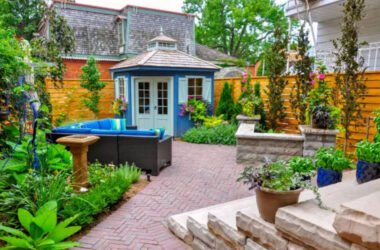Creating a beautiful outdoor space doesn’t have to mean endless hours of labor or complicated maintenance. With a few smart choices and a little planning, you can transform your yard into a lush haven that requires minimal upkeep. From the right plant selection to efficient garden tools, here are some straightforward landscaping ideas to help you achieve a gorgeous, low-maintenance garden.
1. Choose the Right Plants for Your Climate
One of the most effective ways to reduce garden maintenance is by choosing plants that thrive in your specific climate. By selecting native plants or drought-tolerant species, you’ll reduce the need for constant watering and fertilizing, making your garden more sustainable in the long run.
Native plants are adapted to the local environment and require less care. They have deep root systems, which allow them to survive in conditions with less water. On the other hand, drought-tolerant plants can withstand dry spells without the need for frequent irrigation.
When selecting plants, make sure to consider their sunlight, soil, and water requirements. If you’re uncertain, visit local garden centers or consult gardening guides online. For example, The Spruce, a well-respected gardening resource, offers expert advice on selecting the right plants for different climates.
2. Install Hardscaping Features
Incorporating hardscaping elements like stone paths, gravel driveways, and patios into your yard can significantly reduce maintenance. Hardscapes require minimal care compared to plants, making them an excellent option for a low-maintenance garden.
A well-designed stone path can lead visitors through your garden, creating visual interest and serving as a practical element for avoiding muddy spots. Gravel areas are great for filling in spaces where grass might struggle to grow, and patios can offer a designated area for outdoor relaxation without the hassle of grass trimming.
With the right hardscaping, you’ll spend less time pulling weeds and mowing, allowing you to enjoy the aesthetic benefits without the constant upkeep.
3. Use Mulch to Suppress Weeds and Retain Moisture
Mulching is a simple yet highly effective gardening technique that helps keep weeds in check while also retaining soil moisture. By laying a thick layer of mulch around plants, you create a barrier that prevents sunlight from reaching weed seeds, inhibiting their growth. At the same time, mulch helps the soil stay moist, reducing the need for frequent watering during dry spells.
Organic mulches like wood chips or bark are ideal because they break down over time, adding nutrients to the soil. However, they need to be replenished annually to maintain their effectiveness. If you’re looking for a longer-lasting option, inorganic mulches such as gravel or rubber mulch can also do the job with minimal maintenance.
4. Opt for Perennials Over Annuals
Another simple strategy for a low-maintenance garden is to favor perennials over annuals. Perennials come back year after year, so you don’t have to replant them every season. While annuals need to be replanted annually, perennials are more resilient and require less care once established.
Some low-maintenance perennial options include hostas, daylilies, and lavender. These plants often thrive with little more than occasional watering and some pruning at the end of the growing season. Choosing perennials not only saves time and effort but also ensures that your garden remains vibrant throughout the year.
5. Incorporate Low-Maintenance Lawn Alternatives
Traditional lawns can be a lot of work—regular mowing, fertilizing, and watering all add up. If you want to minimize your lawn care efforts, consider switching to low-maintenance alternatives. Ground covers like clover or creeping thyme can create a lush green carpet without requiring constant attention.
Clover, for instance, is drought-tolerant, requires little fertilizer, and doesn’t need to be mowed frequently. Creeping thyme is another excellent option that adds beauty and fragrance to your garden while staying low to the ground.
By reducing the size of your lawn or replacing it with ground covers, you can spend less time on routine maintenance and more time enjoying your outdoor space.
6. Install Efficient Irrigation Systems
A well-designed irrigation system can save you time and water while keeping your plants healthy. Instead of manually watering your garden every few days, an automated sprinkler or drip irrigation system ensures that your plants get the right amount of water at the right time, without any extra effort on your part.
Drip irrigation is particularly effective for low-maintenance gardens because it delivers water directly to the roots of the plants, minimizing water waste. For larger yards, consider installing a smart irrigation system that adjusts the watering schedule based on weather conditions, further reducing maintenance and water usage.
7. Maintain Your Tools and Equipment
Efficient gardening often comes down to having the right tools and using them effectively. If you’re looking to reduce the time spent on yard work, invest in high-quality, easy-to-use garden equipment. Using a canopy on a riding lawn mower, for example, can save you time mowing large lawns while keeping you cool in the process.
Maintaining your tools and equipment is just as important as choosing the right ones. Regularly sharpen your lawnmower blades, clean your tools, and ensure your irrigation system is working properly. A little maintenance goes a long way in ensuring that your equipment lasts longer and works more efficiently, reducing your overall workload.
8. Embrace Low-Maintenance Furniture and Décor
If you’re creating a garden that’s not just for plants but also for relaxation, consider low-maintenance outdoor furniture and décor. Materials like teak, aluminum, or resin wicker require minimal upkeep and stand up to the elements.
Teak, for example, is naturally resistant to water, insects, and rot, making it an ideal choice for outdoor furniture. Resin wicker is lightweight, durable, and resistant to fading, so you don’t have to worry about it deteriorating over time. By opting for low-maintenance materials, you’ll ensure that your garden furniture stays in top condition with little effort.
9. Keep It Simple
Sometimes, the best way to keep your yard low-maintenance is to keep things simple. Avoid overcrowding your garden with too many different plants or complicated design features. A clean, minimalist design with a few key elements can create a beautiful, low-maintenance space that’s easy to care for.
Think about how you can simplify your yard. Can you remove any plants that are difficult to maintain? Would a streamlined pathway work better than an elaborate one? Keeping your garden design simple doesn’t mean sacrificing beauty—it just means choosing a design that’s easy to manage in the long run.
Conclusion
A low-maintenance garden doesn’t mean sacrificing beauty. With careful planning, the right tools, and thoughtful plant selection, you can create an outdoor space that requires minimal upkeep while still offering visual appeal. Whether you’re opting for drought-tolerant plants, installing efficient irrigation systems, or choosing hardscaping over constant grass care, these tips will help you design a garden that suits your lifestyle. So go ahead, simplify your yard, and enjoy the carefree outdoor space you deserve.









